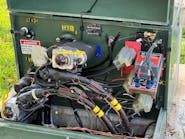It's Time for Utilities to Reconsider Undergrounding Power Lines
Severe weather across the United States has caused nearly half a trillion dollars of damage in the past three years. Hurricane Florence crushed the Carolinas last year; Hurricane Irma flattened Florida in 2017; and Hurricane Matthew slammed Florida and North Carolina in 2016 after laying waste to Haiti and Puerto Rico. On the West Coast, droughts and unusually strong Santa Ana winds have fueled destructive fires. Climate change is unquestionably generating intense, costly storms and rapidly-changing weather patterns, a hard fact that utilities must confront.
Utilities have responded with attempts to harden their infrastructure, replacing some wooden poles with composite or steel, more vigilantly trimming trees, and improving monitoring of power systems. Still, overhead power lines remain very much at risk. In nearly all service territories, except the densest urban areas, most utilities opt not to bury powerlines due to cost. But leaving so much of our power infrastructure exposed to environmental assault may not be worth the short-term cost savings. It’s time for electric utilities to look at undergrounding power lines through a new lens focused not on the short-term costs, but the long-term benefits.
Growing up in Manhattan, where most power distribution is protected below cement and asphalt, I rarely experienced power outages, which informed my perspective that power cables buried underground are safer and more reliable than the relatively fragile poles and wires that line most American streets. Underground power cables are protected from falling trees, flying debris and high winds that come with serious storms. Undergrounding avoids animals that crawl on wires, ice that can snap wires, and fire that can burn down poles and lines. While damaged overhead power wires have ignited and contributed to catastrophic fires in California, underground cables carry virtually no such risk. Overhead wires also require frequent maintenance, while underground cables initially are relatively maintenance free. And, aesthetically, landscapes can be far more pleasing without the jumble of wires and poles.
Over the past two decades, utility commissions in Virginia, North Carolina, Oklahoma, Texas and the District of Columbia have examined the possibility of undergrounding, but all have concluded the transformation could prove to be prohibitively expensive, as the oft-referenced but rarely quantitatively supported “undergrounding is 10 times the cost of overhead” carried the day. Most electric utilities have not pushed for extensive undergrounding, fearing a backlash from customers who want to keep their power bills low.
One utility willing to challenge conventional thinking has scored big with an undergrounding strategy. We Energies’ Wisconsin Public Service subsidiary struggled with the reliability performance on many rural circuits, due largely to tree-related outages. They examined a number of reliability improvement strategies and ultimately settled on a strategy of converting many miles of existing overhead circuitry to underground primary service. This has been a huge success, with reliability up, O&M costs down, capital successfully deployed, and based on the initial results, the size of the original project doubled!
Considering that a distribution infrastructure can last for more than 50 years, the savings from avoiding tree trimming and maintaining clearances, not sending crews to respond to outages and not causing any economic losses from downed power lines should add up. In fact, there is evidence consumers are willing to pay more on their power bills for undergrounding, according to an EEI survey. For utilities that have not updated their undergrounding policies due to fear of increasing the monthly electric bill, the time is ripe to re-examine areas where undergrounding of power lines is appropriate and necessary.
Protecting our power infrastructure is so critical that financing undergrounding should not rely entirely on utility customers bearing the cost. Government should play a role as well, by investing in a more stable and secure infrastructure to help ensure the power remains on during extreme weather events so the economic dislocation of prolonged power outages can be avoided. Direct investment aside, local planning commissions and code enforcement agencies should explore undergrounding services and secondaries as part of new construction or when new permits are issued. Doing so in high fire-risk areas or regions with large trees off the utilities' right-of-way may help prevent damage to the power system and provide additional reliability to the customers. This is happening in Florida where the state senate has approved a bill that would allow utilities such as Florida Power and Light to accelerate undergrounding to provide additional protection from storms and improve reliability.
Threats against our power infrastructure are rising with the intensity of storms assaulting our communities, which means the need and value of securing power lines will only rise. In an increasingly volatile climate that annually inflicts billions of dollars of damage, it is important for all parties to take a holistic, big-picture view of the benefits of undergrounding. Government, regulators, utilities and their customers need to reassess undergrounding with a lens beyond just looking at the immediate costs and benefits, and instead should weigh its many, often more difficult to quantify benefits against the short-term cost, as we try to prevent our power infrastructure from suffering additional catastrophic damage.


